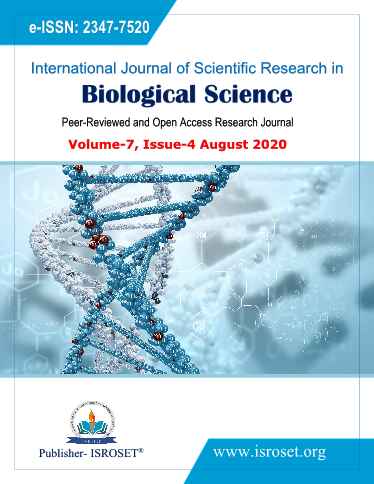Enhancement of Germination and Seedling Health of Rice by Seed Treatment with Antagonist Fungi
Keywords:
Antagonist, Bio-control, Culture filtrate, Seed coating, Seedling health, Seed treatmentsAbstract
Germination and seedling health is important for effective crop establishment. Application of Aspergillus spp. and Trichoderma spp. is the alternative way of intensified germination and healthy seedling production in the crop field. Rice seeds were coated with a spore mass of antagonists showed a significant increase in seed germination and healthy seedlings production compared to the control. At the same time leaf infection, collar infection, root infection, and seedling blight symptoms also decreased remarkably. The highest germination and healthy seedling were recorded 80.33% and 74.37% respectively by T. harzianum treatment. Seeds were subjected to soaking with three water-based culture filtrates (30%, 50%, and 70%) obtained from both three species of Aspergillus and Trichoderma (A. flavus, A. niger, A. terreus, T. viride, T. harzianum, T. hamatum) for 6, 12 and 24 hours. The highest reduction of fungal associations and increased germination was observed 36% and 79.33% respectively in T. harzianum treatment compared to untreated control. The effect was more prominent at the highest dose (70%) and the maximum seed soaking period (24 hours). Apart from all antagonist treatments test fungicide Tilt 250 EC depicted excellent control effect (22.0%). A. niger and T. harzianum were found more potent in reducing seed-borne fungal association as well as improved germination and seedling health.
References
S.M.A. Basra, M. Ashraf, N. Iqbal, Khaliq, R. Ahmad, “Physiological and biochemical aspects of pre-sowing heat stress on cotton seed”, Seed Science & Technology, Vol. 32, pp. 365-774, 2004.
B.C. Das, D.K. Hazarika, “Biological management of sheath blight of rice”, Indian Phytopathology, Vol. 53, Issue. 4, pp. 433-435, 2000.
Raguchander, K. Ranjappan, R. Samiappan, “Evaluating methods of application of biocontrol agent in the control of mung bean root rot”, Indian Phytopathology, Vol. 50, Issue. 2, pp. 229-234, 1997.
N. Boughalleb-M’ Hamdi, I.B. Salem, M. M’Hamdi, “Evaluation of the efficiency of Trichoderma, Penicillium and Aspergillus species as biological control agents against four soil-borne fungi of melon and water melon”, Egyptian Journal of Biological Pest Control, Vol. 28, p. 25, 2018.
V.C. Cuevas, A.M. Sinohin, E.A. Arro, “Efficacy of Trichoderma spp. as biological control agent of Sclerotium rolfsii Sacc” Philippine Agricultural Scientist, Vol. 84, Issue. 1, pp. 35-42, 2001.
F. Surez-Estrella, M.C. Vargas-Garcia, M.U. Lopez, C. Capel, J. Moreno, “Antagonist activity of bacteria and fungi from horticultural compost against Fusarium oxysporum f sp. melons”, Crop Protection, Vol. 26, pp. 46-53, 2007.
B. Sen, “Biological control: A success story”, Indian Phytopathology, Vol. 53, Issue. 3, pp. 243-249, 2000.
J.L. Rytter, F.L. Lukezie, R. Craig, G.W. Moorman, “Biological control of geranium rust by Bacillus subtilis”, Phytopathology, Vol. 79, Issue. 3, pp. 367-370, 1989.
F. Cai, G. Yu, P. Wang, Z. Wei, L. Fu, Q. Shen, W. Chen, “Harzianolide a novel plant growth regulator and systemic resistance elicitor from Trichoderma harzianum”, Plant Physiology & Biochemistry, Vol. 73, pp. 106-113, 2013.
H.J. Bhosale, S. Raut., T.A. Kadam, Antifungal activity of Streptomyces longisporoflavus isolated from Lonar Lake against Alternaria solani, International Journal of Scientific Research in Biological Sciences, Vol.5, Issue.3, pp.21-26, 2018.
K. K. Biswas, C. Sen, “Management of stem rot of groundnut caused by Sclerotism rolfsii through Trichoderma harzianum” Indian Phytopathology, Vol. 53, Issue. 3, pp. 290-295, 2000.
ISTA, “International Rules of seed Testing Association. International Rules for seed testing”, Chief Editor, S.R. Draper, ISTA, Zurich, Switzerland, 2003.
K.A. Gomez, A. A. Gomez, “Statistical Procedure for Agricultural Research (2nd edition). International Rice Research Institute”, J. Willey International Scientific Publication, pp. 28-192, 1984.
W.A. Shabir-U-Rehman, D.S.A. Ganie, J. A. Bhat, G.H. Mir, R. Lawrence, S. Narayan, P.K. Singh, “Comparative efficacy of Trichoderma viride and Trichoderma harzianum against Fusarium oxysporum f sp. ciceris causing wilt of chickpea” African Journal of Microbiological Research, Vol. 7, Issue. 50, pp. 5731-5736, 2013.
A. Khair, B.S. Samadder, H.A. Begum, K. Sultana, “Antagonism of Trichoderma viride on the fungal pathogens of Jute (Corchorus capsularis L. and Corchorus olitorius L.)” Bangladesh Journal of life Science, Vol. 10, Issue. 1&2, pp. 25-30, 1998.
S.K. Jayalakshmi, S. Raju, R. Usha, V.I. Benagi, K. Sreeramulu, “Trichoderma harzianum L1 as a potential source for lytic enzymes and elicitor of defense responses in chickpea (Cicer arietinum L.) against wilt disease caused by Fusarium oxysporum f. sp. Cicero”. Australian Journal of Crop Science, Vol. 3, Issue.1, pp. 44-52, 2009.
F. Doni, I. Anizan, C.M.Z. Che Radziah, A.H. Salman, M.H. Rodzihan, W.M.W. Yousoff, “Enhancement of Rice Seed Germination and vigour by Trichoderma spp”, Research Journal of Applied Sciences, Engineering and Technology, Vol. 7, Issue. 21, pp. 4547-4552, 2014.
Z. Zheng, K. Shetty, “Enhancement of pea (Pisum sativum) seedling vigor and associated phenolic content by extracts of apple pomace fermented with Trichoderma spp,” Process Biochemistry, Vol. 36, pp. 79-84, 2000.
G.E. Harman, C.R. Howell, A. Viterbo, I. Chet, M. Lorito, Trichoderma species- opportunistic, avirulent plant symbionts,” Nat Review of Microbiology, Vol. 2, pp. 43-56, 2004.
V. Mancini, G. Romanazzi, “Seed treatments to control seed-borne fungal pathogens of vegetable crops,” Pest Management Science, Vol. 70, pp. 860-868, 2014.
Downloads
Published
How to Cite
Issue
Section
License

This work is licensed under a Creative Commons Attribution 4.0 International License.
Authors contributing to this journal agree to publish their articles under the Creative Commons Attribution 4.0 International License, allowing third parties to share their work (copy, distribute, transmit) and to adapt it, under the condition that the authors are given credit and that in the event of reuse or distribution, the terms of this license are made clear.







